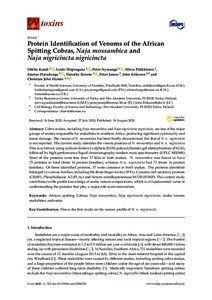Protein Identification of Venoms of the African Spitting Cobras, Naja mossambica and Naja nigricincta nigricincta
Timothy Rennie; Erastus Haindongo; Ottilie Katali; Peter Nyarangó; Mirva Pääkkönen; John Eriksson; Peter James; Loide Shipingana; Christian John Hunter
https://urn.fi/URN:NBN:fi-fe2021042824151
Tiivistelmä
Cobra snakes, including Naja mossambica and Naja nigricincta nigricincta,
are one of the major groups of snakes responsible for snakebites in
southern Africa, producing significant cytotoxicity and tissue damage.
The venom of N. mossambica has been briefly characterised, but that of N. n. nigricincta is not reported. The current study identifies the venom proteins of N. mossambica and N. n. nigricincta.
This is achieved using sodium dodecyl sulphate (SDS)-polyacrylamide gel
eletrophroresis (PAGE), followed by high-performance liquid
chromatography-tandem mass spectrometry (HPLC-MS/MS). Most of the
proteins were less than 17 kDa in both snakes. N. mossambica was found to have 75 proteins in total (from 16 protein families), whereas N.n. nigricincta
had 73 (from 16 protein families). Of these identified proteins, 57
were common in both snakes. The proteins identified belonged to various
families, including the three-finger toxins (3FTx), Cysteine-rich
secretory proteins (CRiSP), Phospholipase A2 (PLA2) and Venom
metalloproteinase M12B (SVMP). The current study contributes to the
profile knowledge of snake venom compositions, which is of fundamental
value in understanding the proteins that play a major role in
envenomation
Kokoelmat
- Rinnakkaistallenteet [19250]
